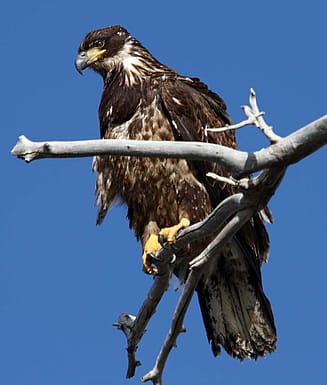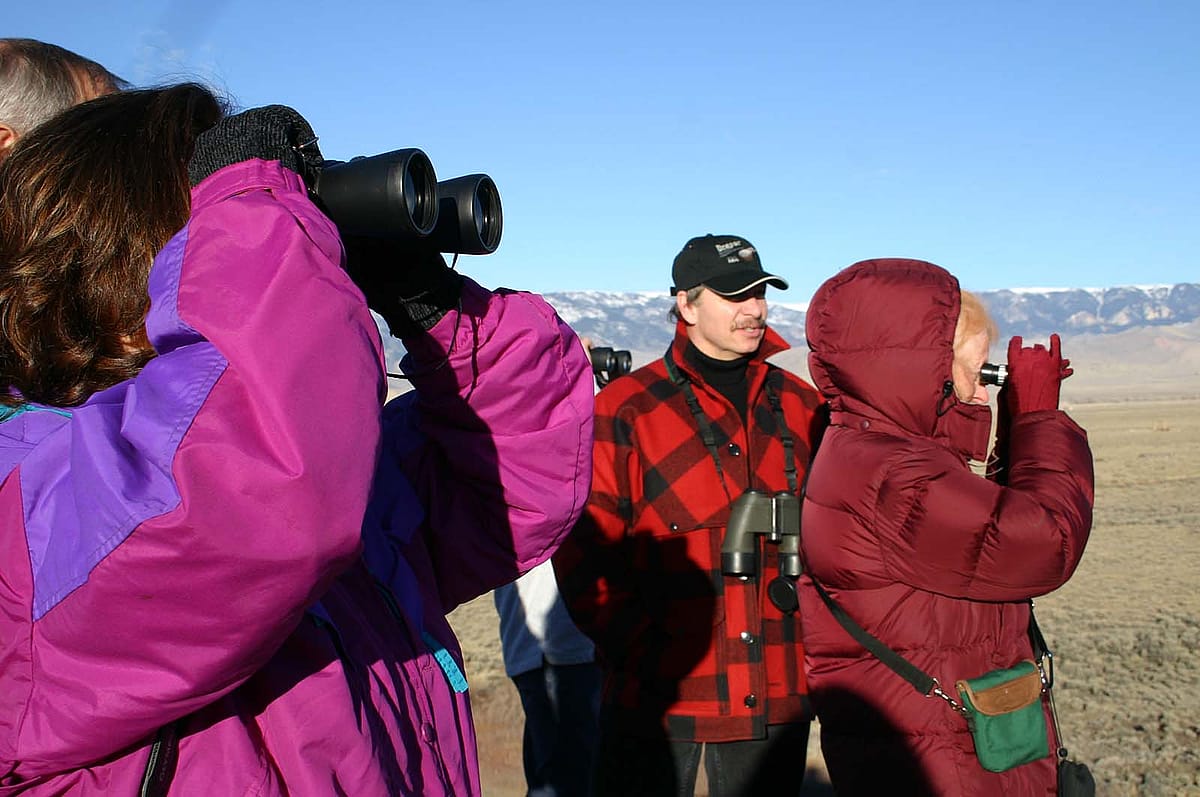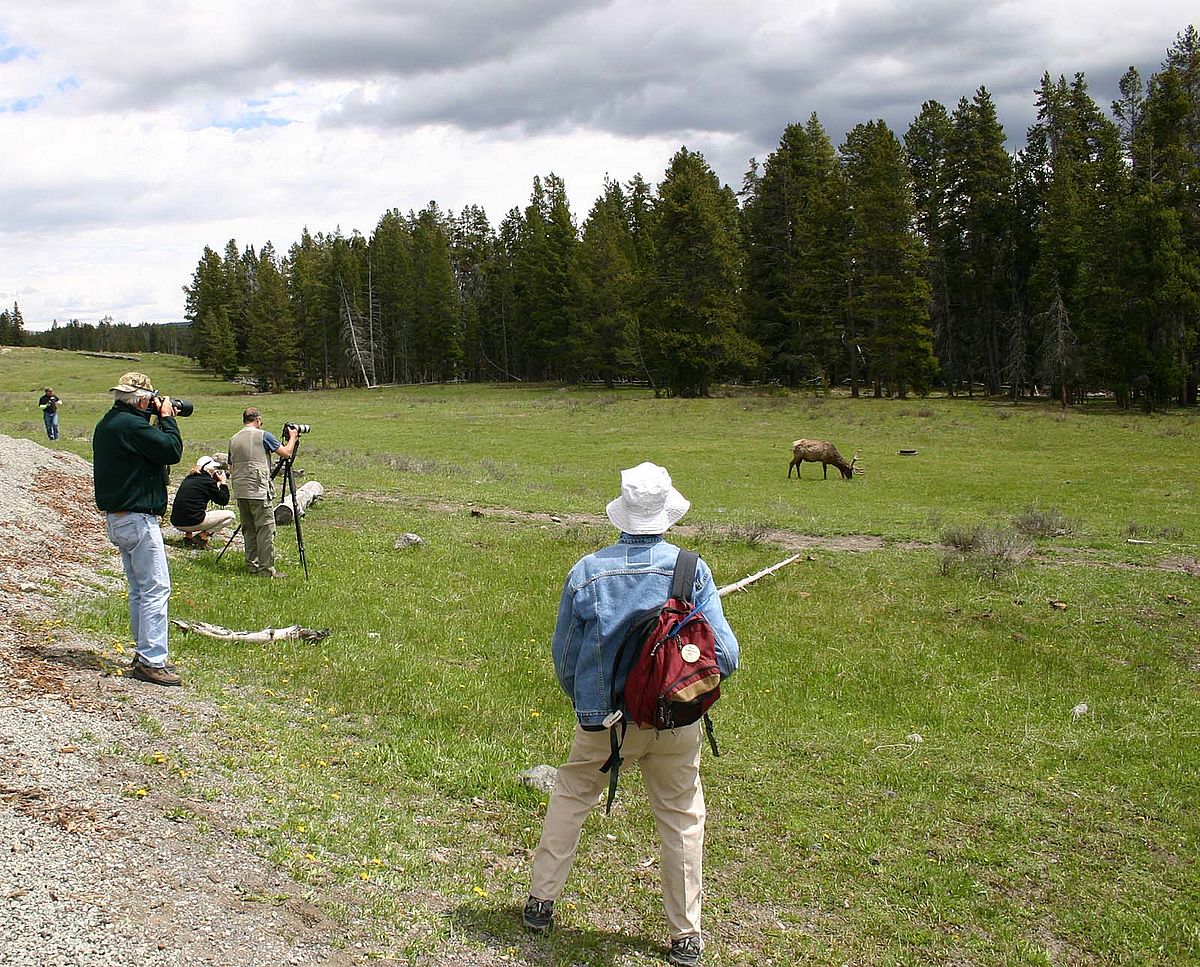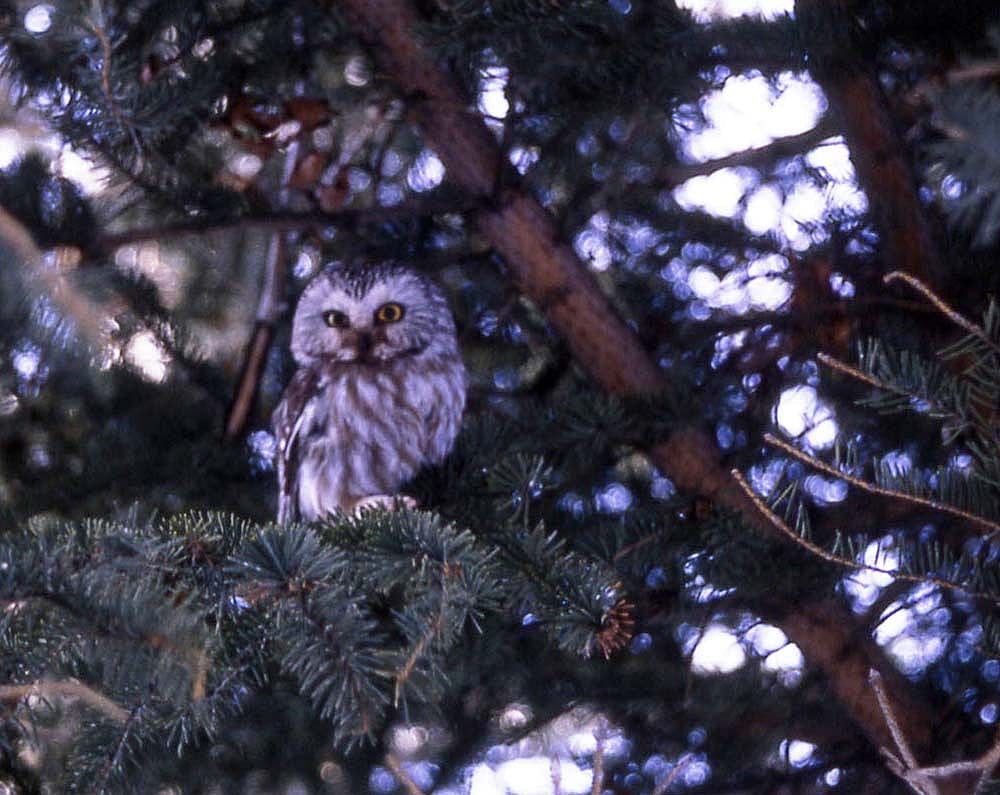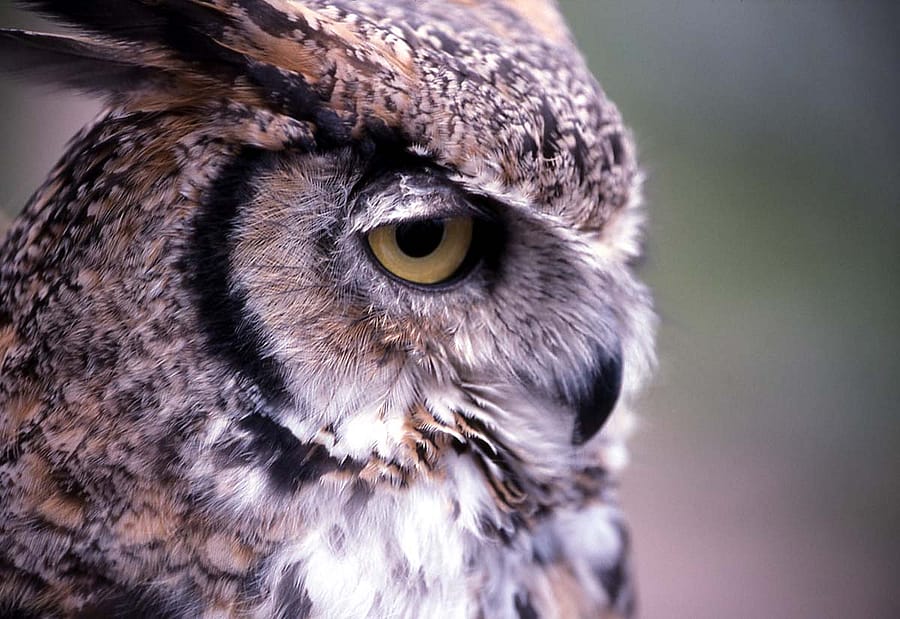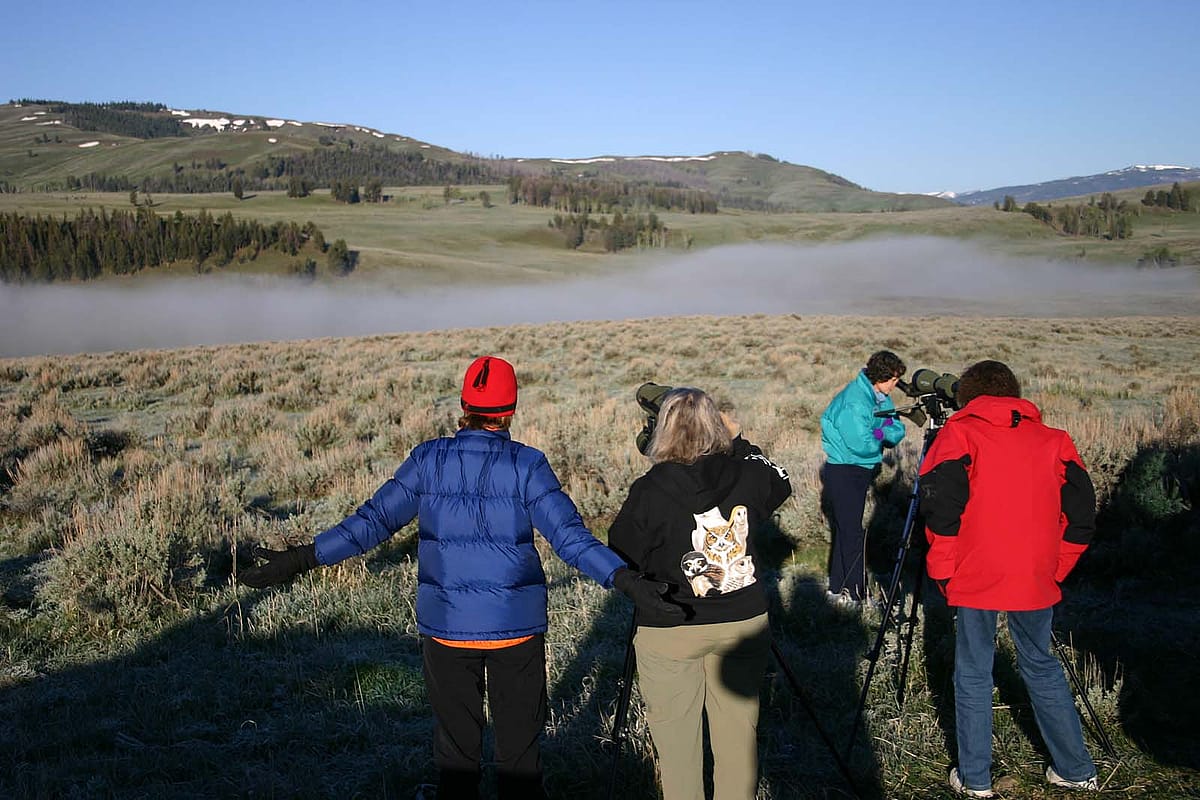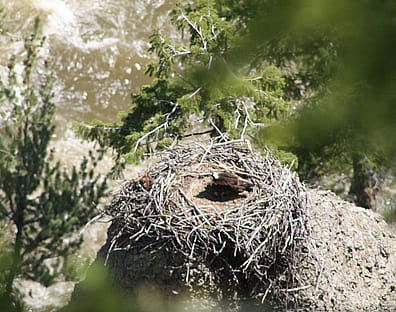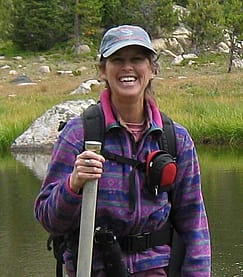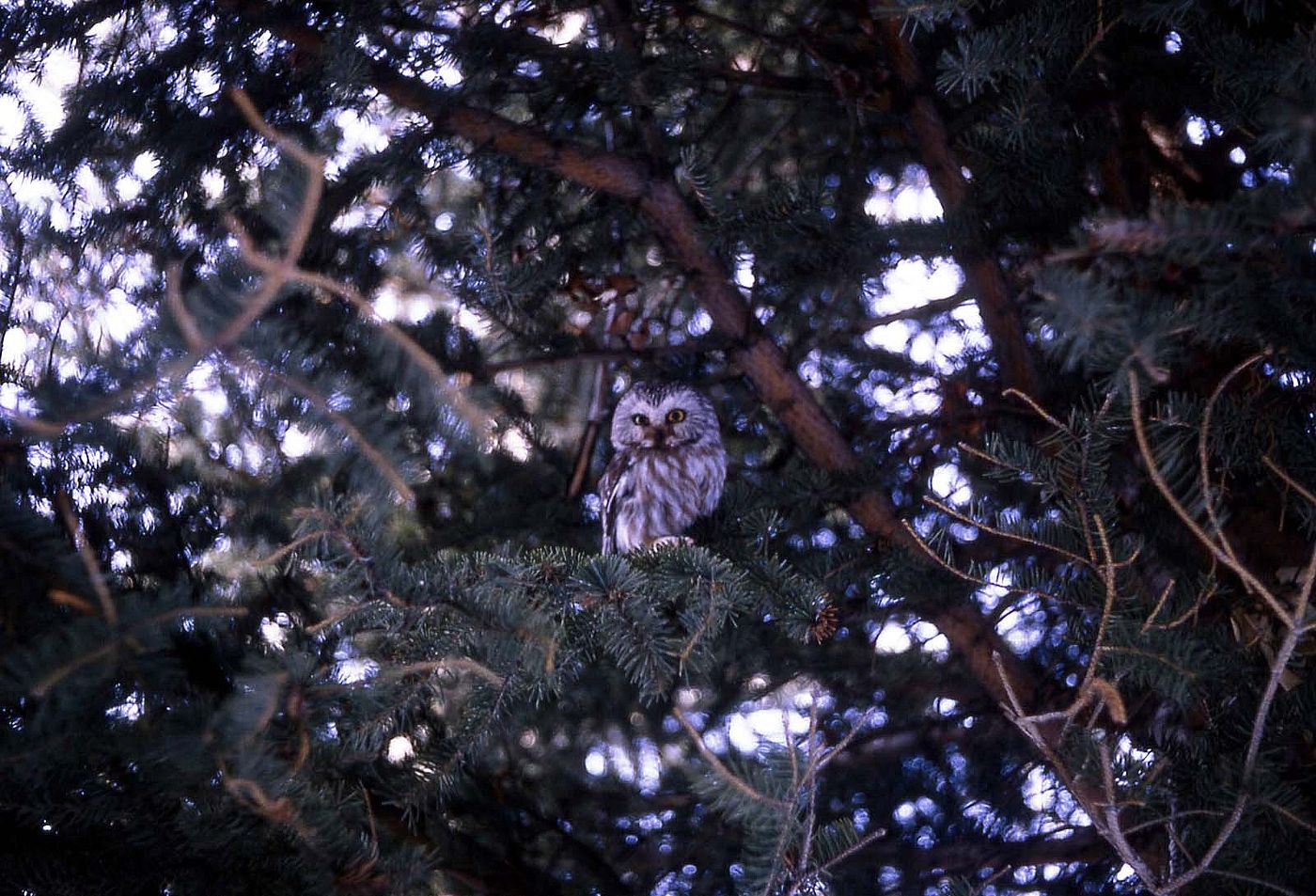
Taking to the Field with the Draper Natural History Museum – Points West Online
Originally published in Points West magazine
Spring 2010
Taking to the Field with the Draper Natural History Museum
By Jennifer McDonald
Nature buffs are always excited at the opportunity to “take to the field” to experience the wildlife of the Greater Yellowstone region—especially in the company of the knowledgeable staff of the Draper Natural History Museum. This past article by former Program Manager Jennifer McDonald shares insights into three popular field expeditions she led in 2009.
Winter Eagle Watch
The bald eagle rose sharply over the river, paused, and watched for any sign of movement in the water below. Then it wheeled, dived, and pulled up just above the surface, but to no avail: The fish escaped. As the eagle banked toward two geese perched oddly on the cliff high above, their heads raised in alarm. Raucous honks echoed off the rocks as they frantically beat their wings and made their exit. In our binoculars, we could see the detail of each eagle feather, and as we hushed our voices, we heard the hiss of feathers sliding through the air when the eagle glided overhead.
During the Winter Eagle Watch Field Expedition, Dr. Charles R. Preston, [then] curator of the Draper Natural History Museum, fifteen guests, and I were treated to so many exciting and rare sights, we hardly knew what to talk about first. The eagle we watched fishing over Wyoming’s Clark’s Fork River had spent at least fifteen minutes performing aerial antics so close to us that we were speechless. We observed so many bald and golden eagles, as well as rough-legged and red-tailed hawks, that it was easy to lose track of how many we’d seen. By noon, we were ready for lunch and reviewed the morning’s highlights over bowls of hot chili at a small café near Clark, Wyoming. An unexpected and delightful sighting was the fifteen or so black rosy finches in the willow trees right next to the café.
The day’s last highlight came as we joined local raptor rehabilitator, Susan Ahalt of Ironside Bird Rescue, at the mouth of Clark’s Fork Canyon as she released a juvenile red-tailed hawk she had nursed back to health. We all gathered around and admired the bird up close as Susan gently removed it from the crate. Next, she asked us all to take a step back so she could remove the hood from the hawk’s head. The bird’s eyes blazed, ready to take on anything the wilds of Wyoming could dish out. Susan prepared us for what the bird was likely to do upon release, and then she gave the words, “OK— now!” as he was tossed gently into the air. The bird lifted, hesitated, and landed back on the ground at our feet. After getting his bearings, though, he took off and flew with great strength back to a life in the wild.
Owl Prowl
Eagles are relatively easy to observe as they are big and usually perch in prominent places. Owls, on the other hand, are a bit harder to see, but will readily respond to the calls of other owls when they are defending territories and attracting mates. Breeding season is a good time of year to locate owls using recorded calls. On a frigid, late-February evening in 2009, fifteen “Owl Prowlers” joined Natural History Educator Emily Hansel Buckles and me on an excursion to Yellowtail Wildlife Management Area near Lovell, Wyoming.
At the first stop, we made our way through the dry, squeaky snow to the edge of the parking area. It was a cold, clear night, and the stars glistened in the sky. Young cottonwood and Russian olive trees created a tangle of branches in the dark. I played the calls one by one, starting with the smaller owls like screech owls and saw-whet owls and worked up to the big one—the great horned owl.
Anticipation was running high as I paused the CD player, and we listened: silence. I played another series of calls with no luck. Finally, we got a response: A chorus of coyotes yipped away in the distance, and while appreciated, it wasn’t what we hoped for. After a few more times playing the owl calls to no effect, we decided to drive on and try another spot. We are careful not to play calls in the same spot more than once or twice as repeated calling could cause the birds undue stress and disrupt their reproduction. By now, the crew was beginning to joke about whether or not one can really get owls to call back, let alone actually get a glimpse of one.
At the next stop, I again played the whole series of calls—still no response. I played the great horned owl calls a second time and was surprised and thrilled when an eastern screech owl answered. They usually react to great horned calls by being very quiet, but then there was a second call. The owls whistled back and forth with each other and my CD player. After several minutes, one came closer, and even those in our group who at first could not hear the calls well, now smiled and nodded that they could.
“I never knew an owl could make a sound like that,” several people exclaimed. Now, everybody was a-buzz with excited chatter, and we loaded back into the vans to see what else we could find.
After a couple of fruitless stops, we heard three species from one place. There was a great horned owl in the distance, a long-eared owl close by, and a saw-whet owl that tooted away and wouldn’t quit. Now all we needed was to see an owl, a sight everybody was ready for after hearing so many.
At the last stop, a great-horned owl responded from a good distance away. I played my CD; the owl called back. I played again; it hooted back. This happened for a good ten minutes with the owl no closer. I took a little break, played the CD again, and suggested to an increasingly cold and restless group that we wait just a moment or two longer.
We had not heard the owl in several minutes, and I was worried that it had flown away. Suddenly, the owl hooted loudly from a spot right in front of us! It had flown in silently and seemed ready to finally chase the “intruder” away. I played the great horned owl track one more time, and then the owl’s mate joined in. We listened for several minutes as the pair hooted a duet from a mere fifteen yards away.
Finally, since everyone wanted a look at them, we turned on our flashlights, and there in the top of the cottonwood we could see one of the owls, its white throat patch puffing out as it hooted. The pair flew off a short distance, and we lost sight of them. Thrilled—and now thoroughly chilled to the bone—we broke out the hot chocolate and brownies for a tailgate party under the stars.
Predator Parade
On the last Saturday in May 2009, fifteen guests, Preston, and I left the Center at 4:30 a.m.: One needs to get up early to look for wolves and bears in Yellowstone National Park’s Lamar Valley. We drove along the Chief Joseph Highway and arrived at Yellowstone National Park’s Northeast Entrance at Silver Gate, Montana. Just as the sun started to rise, we saw several groups of cow elk in the green meadows, their new summer coats sleek and red. But that was only the beginning.
After we passed through the entrance, we caught a glimpse of a moose, and shortly after that, a stop near some cliffs gave us a nice look at a mountain goat—an uncommon sight since mountain goats are not native to Yellowstone and only inhabit the northeast corner of the park in the Absaroka Mountain Range. Mountain goats colonized the park from areas farther north where they were introduced by the Montana Department of Fish, Wildlife and Parks to provide hunting opportunities. This particular goat was just resting on the rocks and chewing its cud. After everyone got a look, we moved farther west into Lamar Valley itself.
At a pullout commanding a good view of the entire valley, we parked and set up spotting scopes. Several in the group had never seen a wolf and were very hopeful of spotting one. We located a herd of elk grazing on the bench across the river, a large herd of bison on the sagebrush flat next to the river, and a bald eagle nest in a large Douglas fir tree.
Suddenly, someone called out, “There are two wolves approaching the elk!” Excitement ran high, and we all repositioned our scopes toward the elk. Alas, the “wolves,” as is often the case, were in fact coyotes. They approached the elk—which stood tall and faced the coyotes—to within fifteen yards or so, paused only for a few moments, and then meandered on down the hill and out of sight.
Minutes later, though, coyote’s big cousin did appear: The wolf was decidedly long-legged and large, even at a mile away, and it was black—a dead giveaway that this “wild dog” was not a coyote. It trotted leisurely through the sagebrush and past the bison, showing no interest in them nor they in him—finally disappearing out of sight behind a hill.
In the meantime, no bears yet, but with everyone’s mood flying high, we set out for the Tower Falls area and then Hayden Valley.
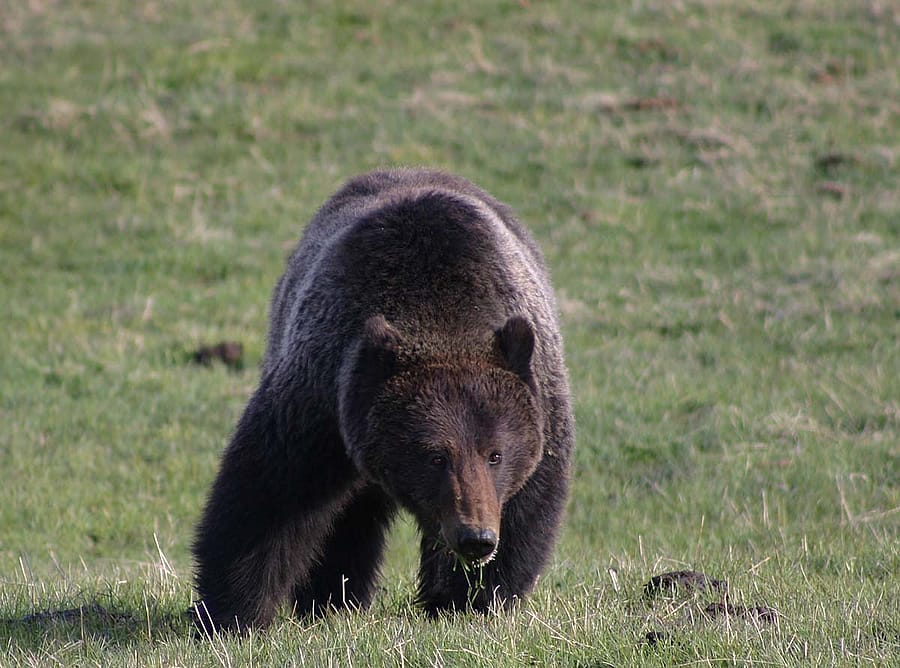
On the way, we spotted two grizzlies, one large and one small, high on a hill. After watching the way the bigger one followed the other, we realized we were sneaking a peak at grizzly bear courtship. We laughed as the male edged closer, and the female continued to walk away.
Near Tower Junction, we observed bighorn sheep ewes with lambs on cliffs above Tower Creek, peered down into an osprey nest in the canyon below, and finally spotted the peregrine falcon Preston had assured us usually had an eyrie (nest) there. On Mt. Washburn, we tried in vain to locate bears with our spotting scopes and binoculars. At the same time, we realized how tired we were; after all, it was now 2 p.m., and we had been up since 3:30 a.m. or so!
We decided to make one last stop at Trout Creek in the Hayden Valley where I had seen a grizzly sow with a yearling cub the week before. Sometimes, sows with cubs don’t journey far, so we hoped they might still be in the area—and they were! In fact, they were only a hundred yards from the spot I had seen them the week before. Even better, the sow was on her back, nursing the cub. It was an amazing end to an amazing day.
Up close and personal in the Greater Yellowstone region
The Draper Natural History Museum connects people with the Greater Yellowstone region in many ways, but our field expeditions were some of the best—and most popular—ways to know it in a personal way.
About the author
At the time this article was written, Jennifer McDonald was the Program Manager for the Draper Museum. She is a Certified Interpretive Guide, has a BA in Biology from Earlham College in Richmond, Indiana, and her areas of specialty include large mammals and birds. She called the Yellowstone area home from 1993–2011. In 2019, McDonald earned her Master of Divinity degree from Asbury Theological Seminary, and is now a pastor.
Post 309
Written By
Nancy McClure
Nancy now does Grants & Foundations Relations for the Center of the West's Development Department, but was formerly the Content Producer for the Center's Public Relations Department, where her work included writing and updating website content, publicizing events, copy editing, working with images, and producing the e-newsletter Western Wire. Her current job is seeking and applying for funding from government grants and private foundations. In her spare time, Nancy enjoys photography, reading, flower gardening, and playing the flute.
